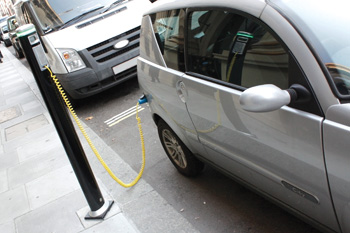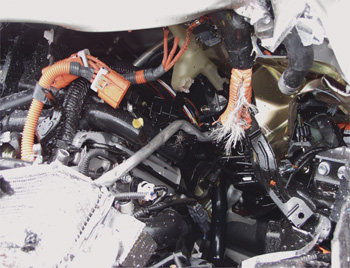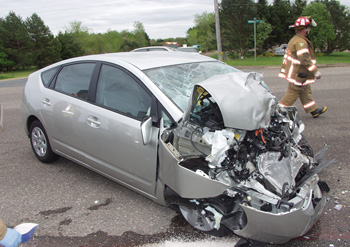Adapted from Mitch Becker’s article in BodyShop Business
 By now, most of the panic caused by the prospect of working on hybrid electric (HEV) vehicles and electric vehicles (EV) is winding down. Most collision repairers have realized that with instructions and some common sense, these vehicles can be repaired just as safely as any other vehicle in the shop. The threat of being hurt is there, as is working on any vehicle. The difference is that shops have more access to repair information than ever before.
By now, most of the panic caused by the prospect of working on hybrid electric (HEV) vehicles and electric vehicles (EV) is winding down. Most collision repairers have realized that with instructions and some common sense, these vehicles can be repaired just as safely as any other vehicle in the shop. The threat of being hurt is there, as is working on any vehicle. The difference is that shops have more access to repair information than ever before.
Repair facilities that provide technicians with instructions and training have found that the techs can be more productive and the shop itself can have fewer warranty issues and provide a safe work environment. This approach has proven to be effective with any new vehicles and their technology.
HEV Owners
The majority of people who have purchased HEVs have found they really enjoy them. Many have developed a devotion to their vehicle, but it isn’t about a particular model or brand. The consensus is always the same: the performance is great, the acceleration is good to great and the handling is smooth. Many even want to add a second HEV to the family. The fuel economy has a tendency to sway owners, also.
Another interesting trend is that an increasing number of people involved in motor vehicle crashes want their vehicles totaled. But HEV and EV owners tend to want their vehicles back, realizing they can be repaired. They tend to do their homework on the vehicles and their values. Many owners plan on keeping the vehicles for a long time and seek out quality shops with lifetime warranties that will exceed the
manufacturers’ warranties. These same owners plan to pass the vehicles down to their kids.
Training
So if a proper repair is crucial to allowing these vehicles to stand the test of time, what should shops do to ensure this? The first step is to pursue training. There are some specifics about HEVs and EVs that need to be addressed. If a technician is to work safely and efficiently on these vehicles, knowledge is a necessity. Understanding how these vehicles operate will lead to better damage diagnosis and repair.
 Batteries
Batteries
The first and most talked about issue is batteries. When the first EVs were introduced back in the late 1800s, most people did not travel far, so limited range was not a drawback. Today’s vehicles need more range, so the HEVs were released to the public.
When first introduced, everyone was shocked at the cost of replacing NiMH batteries. Today, however, with mass production and more available choices, vehicle prices as well as the cost of buying NiMH batteries have dropped dramatically. This has made these vehicles much more repairable.
The introduction of extended range vehicles has brought a change to batteries available as well. With lightweight and powerful lithium batteries entering the market and the reduced cost of making them, we’ve seen a jump in pricing that will eventually come down in the market. Many damaged batteries can be repaired, saving not only on the cost of repairs but reducing total loss ratios. More companies that sell remanufactured battery packs are popping up every year.
The Basics
Let’s put together some basics for shops and take a look at the future.
Technicians should be taught how to recognize high voltage systems – a must as it is not just the battery that runs high voltage. A/C systems and steering also run high voltage, even in normal internal combustion engine vehicles, as noted by the new ESC systems in many vehicles.
High voltage wiring should not be repaired. Identifying components and wiring is well documented in the instructions.
Equipment required would be electrical lineman’s gloves rated to class 0. A shop should have two sets in case one gets wet or a second person is needed for some procedures. Once the disabling procedures for high voltage are done and voltage is confirmed to be disabled, the gloves should go into a protective box or case to avoid damage. Even a pinhole could lead to serious injury! Have the gloves certified at recommended time intervals.
Disconnect a 12-volt system by removing the cables and wrapping them or shielding them from reconnecting to the vehicle battery or touching structure.
While wearing electrical lineman’s gloves when removing the High Voltage Battery Disconnect, be sure to understand that its function is to disconnect power to the vehicle. The power in the battery remains. The disconnect can occur from the flipping of a switch, to flip, slide and pull, to a rotating style similar to a dial. Once removed, place it in a safe place to avoid damage or someone trying to start the vehicle when it shouldn’t be started. Use a high-voltage DVOM (Digital Volt Ohm Meter) to verify that the high-voltage capacitors have discharged before starting work.
Once the power is removed, the transmission in many models may lock up. This will most likely already have been done by “first responders” if they followed their disable procedures. The removing or cutting of 12-volt cables may cause this to happen. A good set of GoJaks for each wheel will help to move and work on the vehicle. Once the integrity of the vehicle’s electrical system is restored, you can roll it on its own wheels. This will make it easier to get it into the paint booth, as GoJaks don’t like drain grates in the shop floor or seals at the bottom of the paint booth door.
When welding near any vehicle electrical components, consult vehicle manufacturer directions to learn what is “too close” – batteries and modules may need to be removed. This procedure should be followed when working on any vehicle. If the OE requires that the battery be removed, follow all manufacturer guidelines to avoid injury or negating the warranty. Although the structures are similar and the repair similar to their internal combustion engine counterparts, a little care can prevent unnecessary damage to electronics.
Refer to vehicle manufacturer instructions on heat and battery packs during repairs as well. The vehicle is designed to protect itself and cool its batteries when temperatures rise. These systems are disabled in paint booths, and temperature must be considered when deciding if the battery should be removed. Be aware of any type of forced heating during repairs or priming as to the direction and duration of heat on battery packs.
A/C Systems
There has been much confusion with the repairs of A/C systems on HEV vehicles. The systems are similar and have the same fittings for the A/C recovery systems currently in use, but the compressor oils are different. The A/C compressor runs on the same voltage as the high voltage battery. The non-conductive compressor oil prevents grounding to the chassis. The refrigerant or R134a is the same, but the oil is different.
Recharging and replacing the compressor oil with the correct part number will prevent costly damage to vehicles’ electrical systems and A/C components. This may require a separate machine from the recovery machine currently in use at the shop, as the current machine may have conductive oil in the manifold of the system. This contamination during recharge costs many shops thousands of dollars in damage. There are flush kits and other applications that may need to be followed for maintenance of your shop’s A/C machine to be used for EV and HEVs. If these procedures are called for and not followed, you’ll need a separate machine dedicated to EV and HEV use only. Vehicle manufacturers may require a separate machine only with no alternatives. If you do not want to purchase a separate machine, have the dealer recharge the system. Many shops tell me that the dealer uses the same machine on all cars, but that’s their liability.
A DVOM can also be used in some cases to see if the A/C compressor is conducting electricity before attaching power and causing damage. I’ve seen many “tricks of the trade” to get around this dilemma, but it comes down to a business decision by a shop to use these alternate methods for recharging. Use a DVOM after charging and before reconnecting the power to prevent some of the costly damage that may occur if the procedure is incorrect.
Scan Tool
A scan tool may be needed to clear codes and reprogram some electronics. Many times, a high voltage diagnostic trouble code (DTC) is caused by not inserting the High Voltage Service Disconnect all the way in for proper connection. This requires following the disable procedures and repeating the enabling procedures. Many times, this code will then clear out. If the code remains, a simple fix would be to use a scan tool to get the code and then access OE repair procedures to read the code. Following the flow charts in the repair information will help you make the correct repair. Throwing new parts at a car and hoping the light goes out is exhausting and expensive.
 What You Need to Repair HEVs and EVs
What You Need to Repair HEVs and EVs
1. Training
2. OEM repair recommendations
3. Techs who have the ability and willingness to follow instructions with no shortcuts
4. Lineman’s gloves; recertify at required time intervals or if
damage is suspected
5. GoJaks to move vehicle
6. High-voltage DVOM to make sure capacitors are discharged and also check A/C
7. Scan tool (possibly); DTC and relearning procedures
8. Common sense
Lightning Strikes
The High Voltage Service Disconnect is designed to protect the vehicle from high voltage surges or irregularities that have been detected.
Recently, an insurance company was having a problem with lightning strikes, not only on but near some of their clients’ vehicle fleets. The vehicles went completely dark. When the dealer was asked to assess damage, the insurance company was told that the systems were destroyed as they could not get any power to the systems to even diagnose the issue. The vehicles were considered total losses.
When I was asked why this happened, my response was, “It shouldn’t have.” The High Voltage Service Disconnect fuse should have tripped to protect the circuits. They went back and replaced the High Voltage Service Disconnect fuses, all power was restored and the vehicles were ready to drive. This simple understanding, plus some instructions, can save a shop much time and cost.


